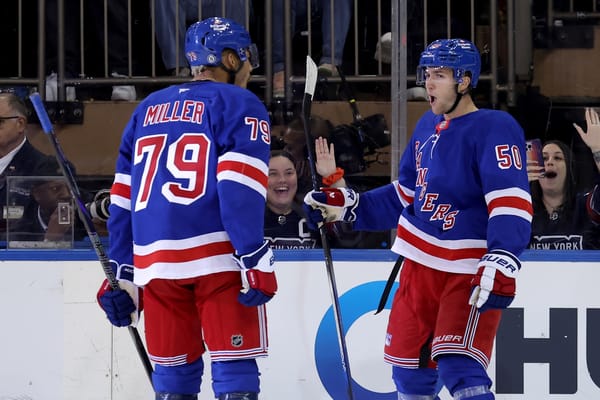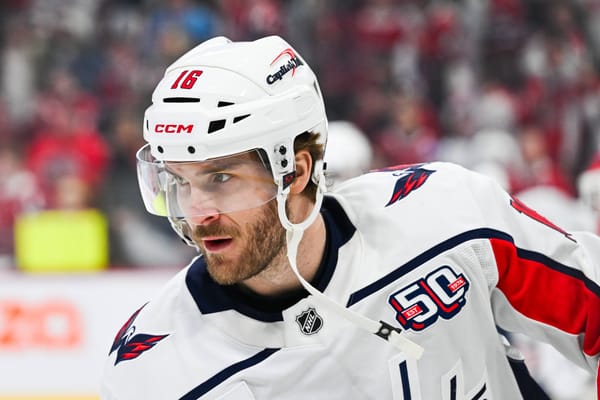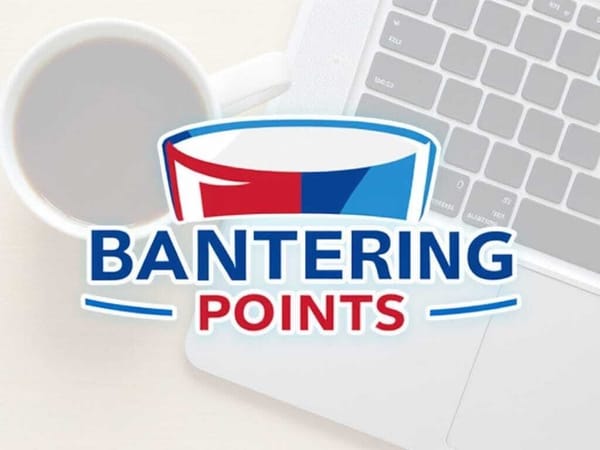What Should a William Nylander Trade Look Like?
If the Rangers opt to pursue Toronto’s star forward, what could they give up in return?
Since training camp began in September and William Nylander didn’t show up with the rest of the Toronto Maple Leafs, much digital ink has been spilled over his future in hockey’s fishbowl. After breaking into the NHL down the stretch of the 2015-16 season, the Swedish forward recorded consecutive 61 point seasons, totaling 135 points over the 185 games his entry-level contract lasted.
As a restricted free agent without arbitration rights, Nylander had little to no leverage. His only options were to accept a contract favorable to Toronto, or hold out, and he’s chosen the latter option. The Leafs have won eight of eleven games to open the 2018-19 season without Nylander, but find themselves in the middle of the league in terms of the on-ice shot and chance battle.
Toronto finished 14th in adjusted Corsi For% and 13th in adjusted Expected Goals For% last season, and currently find themselves 13th and 10th in those same metrics through ten games. For a team that just spent $77 million on the biggest free agent to make it to July 1st since the lockout, a slight uptick in on-ice performance is probably less than what they’re looking for. In the meantime, Nylander has been skating with the Dornbirn Bulldogs of the Austrian Hockey League, although he left the team last week and is yet to return. Conflicting reports have emerged about what the team and the player see as the ideal outcome, but the majority of reports point toward the obvious:
Nylander wants a long-term deal to secure his future in Toronto, and believes his production since entering the NHL speaks for itself. As for Kyle Dubas and the rest of the Leafs’ management, they’d also prefer a long-term deal, just not at a number anywhere close to what the player is seeking ($8.5 million per year according to Elliotte Friedman).
Auston Matthews and Mitch Marner are among seven players on Toronto’s roster set to become RFA’s at the end of the season. Jake Gardiner, the team’s #1 defenseman last season, is set to enter unrestricted free agency for the first time this summer. The Maple Leafs are a team that’s going to look a lot different next October.
Matthews and Marner could easily take up half of their available cap space, and Toronto would still need to fill nine roster spots with around $20 million to spend. Those figures come assuming Nylander isn’t part of the picture, so adding him in would reduce the Leafs cap space to around $13 million for eight roster spots.
With all of that being said, the other 30 teams in the NHL should be calling Kyle Dubas on a daily basis to see what it would take to pry Michael Nylander’s son away. As one of only 44 players to average two points per sixty minutes of 5 on 5 play since breaking into league, the 22 year old winger is the type dynamic talent that doesn’t grow on trees. His numbers on the man advantage are even more impressive, as Nylander is 20th in Points/60 and sixth in Primary Points/60 on the power play. Although he isn’t an elite possession driver in the mold of skaters like Nino Niederreiter and Mathieu Perreault, Nylander is still a net positive in relative shot attempts and chances over the length of his career.
It’s not far fetched to suggest Nylander would be one of, if not the best forward upon his arrival on Broadway. So what would it take for Jeff Gorton to get him here? As a baseline, let’s use the compensation Toronto would receive if Nylander signed an offer sheet with another team:
While Nylander’s initial ask is for an average annual value of $8.5 million, initial asks are always higher than what a player ends up receiving in contract negotiations. As such, Nylander is likely to end up commanding a contract in the range of $7-8 million, which would equal a 1st, 2nd, and 3rd round selection in offer sheet compensation. Given that Nylander is already a proven talent, offering Dubas three lottery tickets for Nylander would get Gorton laughed off of the phone. Even with New York’s 1st round pick likely hovering around #9 again, the Leafs already won the lottery when they turned the 8th overall selection into Nylander back in 2014. A package of draft picks does nothing for Toronto, but we can use their value as an approximation.
A 1st round pick would go back to Toronto under any circumstance, and a look at Toronto’s organizational depth chart would indicate the types of players they could use moving forward. With Tavares, Matthews, and Nazem Kadri all part of the foreseeable future in Toronto, the Rangers could easily make a trade without involving Filip Chytil or Lias Andersson.
Jake Gardiner’s pending departure would make Brady Skjei a sensible trade candidate in a vacuum, but for better or worse, players don’t get traded in the months after signing a six year deal, so Jeff Gorton has likely deemed him a non-starter. Kevin Shattenkirk is in a similar boat, but trading the only legitimate NHLer on the right side of the blue line(while needing to retain salary for the length of the contract as well) should be a no-go for the Rangers.
The Leafs have spent all four of their 1st and 2nd round picks on defenseman over the past two drafts and their top two picks, Rasmus Sandin and Timothy Liljegren, will be breaking into the NHL sooner rather than later. They have a handful of lower ceiling players that have already had cups of coffee in the NHL such as Andreas Borgman, Calle Rosen, and Justin Holl. Ron Hainsey and Martin Marincin are set to join Gardiner as UFA’s on July 1st. Between New York’s probable apprehension toward moving him as well as Toronto’s questionable need for defensive prospects as opposed to players, Libor Hajek is a possibility, albeit an unlikely one.
Toronto acquired Frederik Andersen for two draft picks at the 2016 draft, and he’s been their unquestioned starter since his arrival two seasons ago. However, Toronto’s prospect pipeline is devoid of high ceiling goaltenders, and the Rangers’ surplus of goaltending prospects could be useful here. The team could try to sell Dubas on one of their less prospects like Adam Huska or Tyler Wall, but it would likely require Igor Shesterkin to keep talks from breaking down.
The biggest issue with a potential Nylander trade would both organization’s lack of high upside wingers in the pipeline. Toronto’s top prospects include Jeremy Bracco and Dmytro Timashov, so the team would ideally be seeking a top-flight winger to replace Nylander. Vitali Kravtsov would fit that bill, but the ninth overall selection from this past June would likely be another non-starter for New York.
One wildcard in this picture that I don’t feel confident enough to actively discuss is Chris Kreider. While the Rangers should be doing everything in their power to keep him in New York for a long time, his name has been bandied about in trade rumors similar to Ryan McDonagh’s name last season. If the Rangers are inclined to move him, including him in a package for a proven commodity like Nylander would be preferable to the usual cookie-cutter return of a late 1st round pick and a mediocre prospect.
What makes Kreider a wildcard in this circumstance is how Toronto would react to his name being brought up. He would fit right into the team’s top nine and immensely soften the blow of Nylander leaving, but the questions lie in his contract situation. With one year remaining at a modest cap number of $4.625 million, how Dubas views his contract is anyone’s guess.
The short term and reasonable number could be seen as a boon for the Leafs, as it gives them the flexibility to keep their super team together until 2020 if they can convince their big names to sit tight for one season. Alternatively, the term left on the deal could be something Toronto wants to avoid entirely. If the Leafs want to keep their window open for the next four to eight years rather than maximizing their chances in the short term, acquiring Kreider does nothing for them. He would play out his contract, and exit stage left following the 2019-20 campaign due to the team’s lack of space following mega extensions for Matthews and Marner.
The most likely outcome has been, and will always be, Nylander and the Maple Leafs coming to an agreement on a short-term bridge deal to kick the can down the road. Toronto is in the unique situation of having both a plethora of young stars in need of big money extensions sooner rather than later, as well as veteran stars (only one star, but the point still stands) already on mega deals that are an immovable part of the team’s core. The team will have a much more clear picture of their future twelve months from now, and Nylander’s involvement in that future will be a major factor.
From New York’s point of view, a trade for Nylander would be a departure from the days of acquiring players like Ryane Clowe, Eric Staal, and Brendan Smith. Nylander is a 22 year old star in the prime of his career. The Rangers will need more elite talent than they currently have to compete for the Stanley Cup in the future. If landing elite talent requires giving away mystery boxes that might have elite talent inside of them, than that’s the price Jeff Gorton needs to be willing to pay.
Aside from Kravtsov and Chytil, none of the team’s prospects should be off the table. The Maple Leafs don’t need to force a move with Nylander yet, so they have no reason to rush and accept a bad trade. Not that that alone would stop a team from making a bad trade, but it’s something to keep in mind. Regardless, Nylander is an interesting option that the Rangers should be curious about. It wouldn’t be an easy trade to complete, but Jeff Gorton has the assets to make it happen.
Pulling the trigger on a deal would change the direction of the franchise, both on and off the ice.





